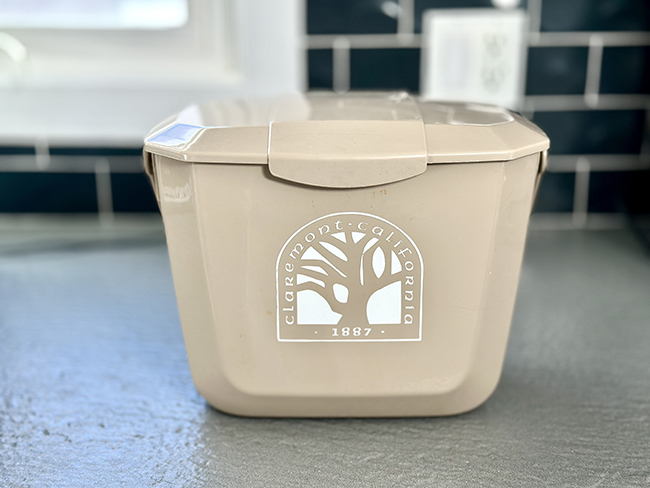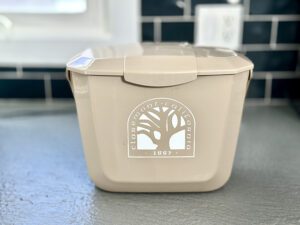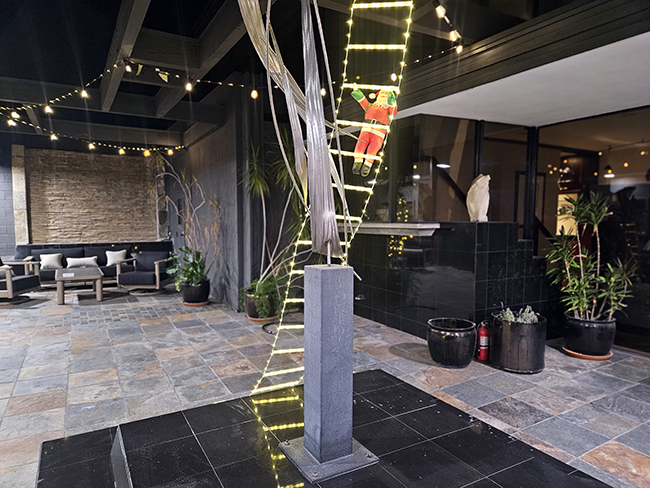State law requires city to inspect (some) trash bins

The City of Claremont offers countertop food scrap collection bins for a small fee. Courier photo/Peter Weinberger
by Steven Felschundneff | steven@claremont-courier.com
During last week’s Claremont City Council meeting, frequent participant Douglas Lyon used his public comment time to complain about a note he found attached to his curbside trash barrel stating that he had thrown certain items away that should have been placed in another bin.
He’s not alone in receiving these notes. Community services staff have been conducting a state-mandated audit of what Claremonters throw away so that the city remains in compliance with a relatively new law governing organic waste.
In 2021 the city updated its municipal code “garbage and solid waste and associated policy” to incorporate the organic material recycling requirements under Senate Bill 1383. The main focus of the law is to divert food waste away from landfills where it can create methane gas pollution.
The law went into effect January 1, 2022. It requires the city to perform “route reviews” to ensure residents are not throwing food items and other organic waste into their black trash bins.
Organic refuse must now be placed in green recycling bins, including edible items such as fruit, vegetables, meat scraps and plate scrapings. Messy food scraps can be placed in clear plastic bags. Residents will continue to also use green bins for yard waste such as leaves, weeds, flowers, plant prunings, and small branches.
Items that must go in the black trash bins include palm fronds, cacti, succulents, large branches, and animal waste. Also, biodegradable or compostable dinnerware must be disposed of in the trash container. The city offers countertop food scrap collection bins for a small fee.

The City of Claremont offers countertop food scrap collection bins for a small fee. Courier photo/Peter Weinberger
“Can we have staff address the situation with the trash because there may be others that have received notices and are wondering about it,” Council member Corey Calaycay asked the city manager during Tuesdays meeting. “I think its important for people to understand the situation.”
“The speaker speculated this is a mandate coming down from the state and that is indeed the case,” said Community Services Manager Kristin Mikula. “The law SB1383 that brought us organic recycling a few years ago includes a requirement that jurisdictions do route review which involves doing a random sample survey to determine the number of contaminated containers.”
She said the department is surveying about 2.5% of residential containers to monitor for contamination and will report their findings yearly back to the state. They are looking for any sign of organic waste in black trash bins such as food scraps or weeds.
The city is required to conduct the random reviews on all four of its residential routes and both commercial routes. The hang tags left on the bins are meant to be educational rather than punitive.
“It’s supposed to be used as education tool and to reduce contamination,” Mikula said about the hang tags.
Mikula said the city is only inspecting the black trash bins rather than surveying all three types of residential containers. She said the absence of any food waste in the green bin is not necessarily an indication that someone is not complying with the law. That person could be composting, or may simply make no food waste.
A Courier reader inquired how food waste at a landfill creates methane, while that same waste at a composting facility produces none. The company with which the city contracts uses covered aerated static pile composting. In this process breathable fabric over the pile helps reduce anaerobic conditions and the amount of methane produced.
During Tuesday’s meeting Calaycay reminded residents that the food recycling program came with an extra cost which is now a line item on their sanitation bill.
4 Comments
Submit a Comment
You must be logged in to post a comment.










I think Steven means “aerobic” instead of “anaerobic” in the second to last paragraph”.
“Large scale waste management recyclers employ anaerobic composting that deprives the process of oxygen and greatly reduces the amount of methane released.”
The sentence above conveys just the opposite of what is intended. That is, aerobic composting (in the presence of oxygen) of food waste/scraps produces very little methane compared to sending food waste/scraps to the landfill where these organics are buried deep into the landfill and soon are in an anaerobic environment (no or little oxygen) where their decay generates substantial methane.
Methane is a very potent green house gas, so this fact underlies all of the State legislation requiring food waste to be diverted from the landfill and instead sent to composting facilities where the food waste can decay in an aerobic environment (lots of oxygen available for the decay process) in which very little methane is generated.
Hi Richard. Thanks for writing and for the info. We are publishing a clarification in this week’s edition. MR
My redlines weren’t included in my previous submission. Here is my correction without redlines:
“Large scale waste management recyclers employ aerobic composting. Aerobic decomposition of organic refuse produces carbon dioxide instead of methane, greatly reducing the amount of greenhouse gas released into the atmosphere.”
Richard has it correct:
“Large scale waste management recyclers employ anaerobic aerobic composting. Aerobic decomposition of organic refuse produces carbon dioxide instead of methane, greatly reducing the amount of green house gas released into the atmosphere. that deprives the process of oxygen and greatly reduces the amount of methane released.”
NRDC has a nice composting description: Composting 101.
https://www.nrdc.org/stories/composting-101#whatis